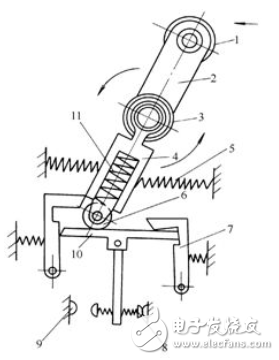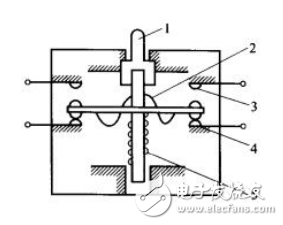In an electrical control system, the position switch functions to achieve sequential control, position control, and position status detection. Used to control the travel and limit protection of mechanical equipment. Construction: consists of the operating head, the contact system and the housing.
The stroke switch can be divided into direct motion type, roller type, micro motion type and combined type according to its structure.
Direct acting travel switchThe principle of action is similar to that of a button. The difference is that one is manual and the other is collided by the collision block of the moving part. When the collision block on the external moving part hits the button to make its contact move, when the moving part leaves, the contact is automatically reset under the action of the spring.
Its structural principle is shown in the figure. Its action principle is the same as that of the push button switch, but the speed of the contact of the contact depends on the running speed of the production machine, and it is not suitable for the place where the speed is lower than 0.4m/min.

Direct-acting stroke switch
1: Push rod 2: Spring 3: Breaking contact 4: Moving contact
Roller type travel switchWhen the armature (crash block) of the motion machine is pressed onto the roller of the travel switch, the drive bar rotates together with the rotating shaft, so that the cam pushes the collision block, and when the collision block is pressed to a certain position, the micro switch is pushed to move quickly. The return spring resets the travel switch when the stop on the roller is removed. This is a single-wheel automatic recovery type of travel switch. The two-wheel rotary travel switch cannot be automatically restored. When it is moved backward by the moving machine, the iron stops against the other roller to recover it.
The structural principle is as shown in the figure. When the collision block on the controlled machine hits the ram with the roller, the ram is turned to the right to drive the cam to rotate, and the push rod is pushed down to make the contact in the micro switch act quickly. When the moving machine returns, the partial moving parts are reset by the action of the return spring.

Roller type stroke switch
1: Roller 2: Upper arm 3&5&11: Spring 4: Rack
6: Pulley 7: Platen 8 & 9: Contact 10: Horizontal plate
The roller type travel switch is further divided into a single-roller automatic reset and a double-roller (crop-type) non-automatic reset type. The double-roller shift switch has two steady-state positions and has a "memory" function, which simplifies the line in some cases.
Micro switch type switch
The composition of the micro-switching type of stroke switch is exemplified by the commonly used LXW-11 series products. The structural principle is as shown in the figure:
1: Push rod 2: Spring 3: Moving contact 4: Breaking contact 5: Compression spring
SHAOXING COLORBEE PLASTIC CO.,LTD , https://www.colorbeephoto.com